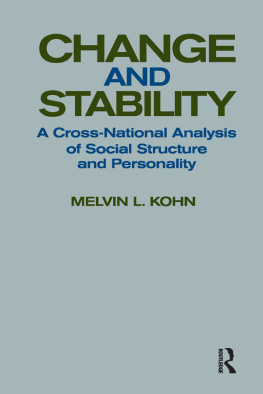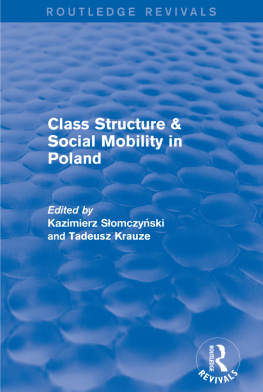First published 2006 by Paradigm Publishers
Published 2016 by Routledge
2 Park Square, Milton Park, Abingdon, Oxon OX14 4RN
711 Third Avenue, New York, NY 10017, USA
Routledge is an imprint of the Taylor & Francis Group, an informa business
Copyright 2006, Taylor & Francis
All rights reserved. No part of this book may be reprinted or reproduced or utilised in any form or by any electronic, mechanical, or other means, now known or hereafter invented, including photocopying and recording, or in any information storage or retrieval system, without permission in writing from the publishers.
Notice:
Product or corporate names may be trademarks or registered trademarks, and are used only for identification and explanation without intent to infringe.
Library of Congress Cataloging-in-Publication Data
Kohn, Melvin L., 1928
Change and stability : a cross-national analysis of social structure and personality / Melvin L. Kohn.
p. cm.
Includes bibliographical references and index.
ISBN 978-1-59451-175-2 (hc) ISBN 978-1-59451-176-9 (pbk.)
1. Social structurePsychological aspectsCross-cultural studies.
2. Social stabilityPsychological aspectsCross-cultural studies.
3. Social changePsychological aspectsCross-cultural studies.
4. Personality and situationCross-cultural studies. 5. Personality
and cultureCross-cultural studies. I. Title.
HM706.K64 2005
155.92dc22
2005015681
Designed and typeset by Straight Creek Bookmakers.
ISBN 13: 978-1-59451-175-2 (hbk)
ISBN 13: 978-1-59451-176-9 (pbk)
None of my books started out to be a book, this one least of all. In each instance, I started with a theoretical or empirical problem, did research directed to solving that problem, moved along from the initial problem to others that came to the fore as each in turn was addressed, published articles about my empirical studies of these problems, and only gradually over the years, as the articles formed larger intellectual entities, felt compelled to bring them all together to elucidate those entities and draw out their implications in what I intended to be comprehensive and coherent volumes.
Class and Conformity: A Study in Values (a double misnomer, for it would have been more accurate, if less alliterative, to call the main title, Social Stratification and Self-direction) was my first such venture. Some reviewers of my later books say that this one established the paradigm, while the subsequent books were normal science, but I see a rather more gradual development of the thesis throughout a long series of articles and books. The core idea was set forth, even if the nomenclature was as yet imprecise, in a speculative paper called Social Class and Parent-Child Relationships: An Interpretation, published in 1963. This paper was incorporated into Class and Conformity, which set forth a somewhat more precise but still incomplete statement of the central thesis and tested it about as well as was possible with only cross-sectional data based primarily on a survey of employed men in a single country, using the statistical methods available forty-some years ago.
That thesis, familiar to anyone who has read any of my writings, is that position in the larger social structure affects (and is affected by) personality primarily because of the strong linkages of social-structural position to more proximate conditions of life, and of the linkages of these conditions of life to individual personality. When one focuses on class and stratification as the dimensions of social structure under investigation, as I generally do, these proximate conditions of life are necessarily mainly occupational, particularly (but not only) the occupational conditions that facilitate or impede the exercise of self-direction in workfirst and foremost, the substantive complexity of that work, but also how closely the work is supervised and how routinized it is. This thesis has stood the test of repeated replication, its validity and its power having been assessed in a host of studies in many countries (see the reviews in Kohn and Schooler 1983, Chapter 12; and Kohn and Somczynski 1990, Chapter 9, especially pp. 251259).
In the second book, Work and Personality: An Inquiry into the Impact of Social Stratification (coauthored with Carmi Schooler), the principal concepts were refined and the empirical analyses broadened in many ways: (1) by distinguishing between social stratification and social class and by developing a conceptualization of social class more consonant with my treatment of occupational conditions than the previous conceptualizations on which I built; (2) by examining the relationships of job conditions to personality for women as well as for men, even though we did not yet have a sample fully representative of all employed women;1 (3) by considerably enlarging the range of job conditions studied, to encompass not only the conditions that facilitate or impede the exercise of occupational self-direction, but all the conditions of work that we termed structural imperatives of the job; (4) by assessing the psychological effects, not only of the work done in paid employment but also of the work done in housework; (5) by examining not only the subjective phenomena we call personality but also (reported) behavior; and (6)cruciallyby using the newly invented statistical techniques of confirmatory factor analysis and linear structural-equations modeling, applied to longitudinal data, to deal frontally with the central interpretive issue in the study of social structure and personality ever since Weberthe direction of effects. Do social-structural position and its attendant job conditions affect or only reflect personality? Schoolers and my (I think, definitive) answer to this long-standing question was that the relationship of social structure and personality is quintessentially reciprocal. I would now add: at least under conditions of social stability.
This might have been the end of my saga were it not for my exceptionally good fortune (described in my limited participation in Leonard Pearlins replication and extension in Turin, Italy, of an early study of mine done in Washington, D.C., and the promise of a full-scale study, testing the heart of my thesis in socialist Poland, was extremely appealing. The idea that a comparative analysis of Poland and the United States might eventuate in a book was the furthest thing from my mind; but here, again, as the analyses progressed and the papers cumulated, my principal collaborator, Kazimierz Somczynski, and I produced, initially, a book in Polish (Somczynski and Kohn 1988), and later a more fully developed version of that book in English, which we called Social Structure and Self-Direction: A Comparative Analysis of the United States and Poland (Kohn and Somczynski 1990).
We characterized the latter book as both the third volume in a trilogy and a new venture, the new venture being to test whether the findings and interpretation of the U.S. research applied as well to a socialist society. In that book, we also incorporated a conceptualization of social class for Polands socialist society that Somczynski had developed, which we used in comparative analyses of social class and personality in the United States and Poland. Again in parallel for the two countries, we traced the consequences of social structure and attendant job conditions, not only for parents values for their offspring, but continuing on to the carryover of parents values to the offsprings own values.









